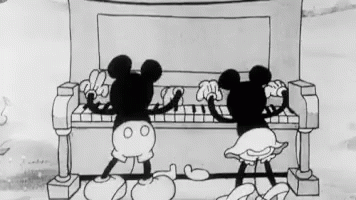Melody & Harmony
Melodies contain single notes of varying in pitches that belong to a particular scale, however they may also contain intervals and chords as well.
This next lesson is an introduction to intervals, scales, and chords however each of these topics will be individually described in more detail over the next couple of lessons as we progress in complexity.
Intervals is a term used to describe the distance between two notes with relation to how far up or down a note is from another note. Unlike the topic of time that describes a note’s duration and its placement from left to right within a measure, intervals describe a notes distance above or below another note. If an object is 5 steps away from another object, intervals would describe if it is 5 steps up or 5 steps down from the original note and whether they are big steps or small steps. The two notes can be spaced diagonally away from one another as in a staircase where one notes is 5 steps up or down from the other, or they may be vertically stacked as in a ladder. More on this a little later.
Scales are a set of 2 or more intervals that are spaced diagonally away from one another as in a staircase. Scales can range from 3 to 12 individual notes and represent the universe of notes available for a musician to select from when composing music in a specific key*. Scale notes may have either an alphabetical letter from A to G or the Latin La, Si, Do, Re, Mi, Fa, Sol as their names. When speaking generally, or when not referring to a specific key, the scale notes, called ‘scale degrees’ are simply named using Arabic/Western numerals from 1 to 8 (in a key with 8 notes). The fifth note of a scale for example is the 5th scale degree. The third note of a scale is the 3rd scale degree and so on.
Chords are a set of 2 or more intervals (consisting of 3 or more notes) that are vertically stacked as in a ladder. All the notes of a chord are played at the same time. There are usually 7 chords within a key that has 8 notes and they too are numbered similar to scales. The difference being that rather than using Arabic/Western numerals, chords use Roman numerals instead. The seven chords would therefore be : I, ii, iii, IV, V, vi, vii. The fourth chord would be IV while the sixth chord would be vi. Notice that I used uppercase for I, IV and V but lowercase for ii, iii, vi and vii. This is intentional and will be explained in more detail in the ‘chords’ chapter however it basically identifies the chord quality (major, minor, augmented, or diminished).
